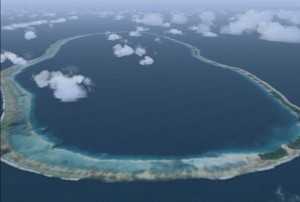Jul

A Tahanea coral (not sand) beach — a quintessential Tuamotu atollscape. Photo courtesy of http://www.panoramio.com.
The trip to Tahanea was a pleasant, easy 24-hour overnight jaunt. This atoll isn’t really a national park — we had heard that it was — but it is completely undeveloped save for a few simple buildings and shacks, none of which were occupied when we arrived.
Heartstoppingly, picture-book pretty: turquoise waters; coral beach mixed with volcanic rock; densely vegetated land area, with coconut palms and a couple of other types of trees and some bushes too. The outer reef is several hundred yards out, with a shallow lagoon between it and the motu itself. Very few flies or bugs ashore, at least in the afternoon. Very picturesque — a desolate paradise.
So where is this, exactly? Grab your atlas or fire up Google Maps or Google Earth and find latitude 16 degrees 50 minutes south, longitude 144 degrees 45 minutes west.
On the motu a couple hundred yards from where we’re anchored there’s a shack in a little clearing with a big water tank to catch runoff from the roof. Nearby is the stoutly built outer frame of what looked like a big rack for drying copra.
Sat 28 May – Still anchored in the SE corner of the Tahanea lagoon. A motorboat with two huge outboard motors, at least 100 hp each, and carrying six or eight locals came in yesterday and navigated very carefully into the shallow but broad and long tidepool that sits between the motu itself and the outer reef. A little while later the motorboat departed with only two people aboard. The guys ashore were all very friendly and welcomed us to walk around the motu, use it as we wanted, etc. They’re going to work here for a few days collecting coconuts and preparing copra, using the shack in the little clearing and the rack by the water’s edge. Copra, dried coconut meat that is pressed for coconut oil, is the main exploitable natural resource in these parts. Yes, fishing is big too, but that’s mostly for pelagic (open-ocean) fish. Ciguatera is enough of a problem that reef fish, while consumed locally (sometimes with harsh consequences), aren’t exportable.
Don’t know how the motorboat got here. Could they really have motored all the way from Fakarava (50-70 miles, depending on which pass you use)? Could they have come from one of the even tinier atolls lying only a few miles away? It’s not the type of boat you’d want to do any open-ocean traveling on in any sort of seas. Could they have been carried aboard the Stella Maris supply ship, which came through the pass the other day and anchored for a few hours? Maybe there’s a larger copra harvesting effort afoot elsewhere on the atoll as well?
Wed 1 June – About 12:30 or 13:00 we weighed anchor and motored up toward the Tahanea pass. We didn’t wait for the tide change or anything — it’s a wide, deep, easily navigable pass — we just blasted through it when we got there and pointed the bow northwest toward Fakarava.

Tahanea, seen from the southeast and looking northwest. The pass to enter the lagoon is hard to spot — it’s about two thirds of the way up the eastern side of the atoll. You can see that the atoll is mostly reef — only the dark green spots are the motus. For some idea of scale, Tahanea is about 48 km (30 miles) long and 15 km (9.5 miles) wide, about middling in size relative to the other Tuamotu atolls. Photo courtesy of http://members3.jcom.home.ne.jp.